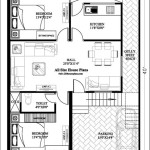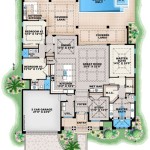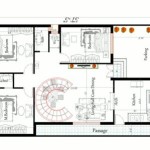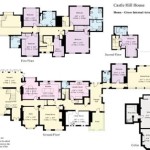Southern Living House Plans With Walkout Basements: Combining Charm and Functionality
Southern Living house plans are renowned for their classic architectural styles, attention to detail, and focus on creating comfortable, livable spaces. The addition of a walkout basement to these plans further enhances their appeal, especially for homeowners in areas with sloping terrain. A walkout basement not only increases living space but also provides natural light, easy access to the outdoors, and opportunities for customization to suit various lifestyles. This article will explore the benefits and considerations of Southern Living house plans designed with walkout basements.
The design philosophy behind Southern Living house plans often centers around blending indoor and outdoor living. Features like expansive porches, screened-in patios, and generous windows are hallmarks of this style. A walkout basement naturally complements this philosophy by providing another point of connection to the surrounding landscape. It allows homeowners to seamlessly transition from the lower level to the backyard, creating an ideal space for entertaining, recreation, or simply enjoying the natural environment.
When selecting a Southern Living house plan with a walkout basement, several factors merit careful consideration. These include the topography of the land, the desired use of the basement space, and the overall budget for the project. Understanding these aspects will help ensure that the final result meets the homeowner's needs and expectations while maintaining the aesthetic integrity of the Southern Living design.
Maximizing Space and Functionality
One of the primary advantages of incorporating a walkout basement into a Southern Living house plan is the substantial increase in usable living space. This additional square footage can be adapted to a wide range of purposes, depending on the homeowner's needs and preferences. Common uses for walkout basements include recreation rooms, home theaters, guest suites, home offices, and workshops. The direct access to the outdoors makes the space feel less like a traditional basement and more like an extension of the main living areas.
For families with children, a walkout basement can serve as an ideal play area or entertainment space. The natural light and easy access to the backyard make it a safe and inviting environment for kids to play and explore. A recreation room in the basement can also help to keep noise and clutter contained, allowing the rest of the house to remain peaceful and organized. Adults can also use the area for entertainment; for instance, a walkout basement could house a billiard or pool table.
Homeowners who work remotely or operate a small business from home often find that a walkout basement provides an ideal office space. The separation from the main living areas helps to create a dedicated workspace, minimizing distractions and enhancing productivity. The natural light and outdoor access can also help to improve mood and reduce stress, making the basement office a comfortable and enjoyable place to work. Furthermore, a separate entrance for the walkout basement can turn the space into a commercial enterprise, such as a salon or small business office. This can be helpful for those who need to separate their work lives from their home lives.
A walkout basement can also be designed as a self-contained guest suite, complete with a bedroom, bathroom, and living area. This provides guests with privacy and comfort, while also allowing homeowners to maintain their personal space. A guest suite in the basement can be particularly useful for accommodating visiting family members or friends, or for renting out as a short-term rental property. The separate entrance from the backyard can give tenants additional privacy.
The flexibility of a walkout basement allows homeowners to customize the space to perfectly suit their unique lifestyle. Whether it's a home gym, a wine cellar, or an art studio, the possibilities are virtually endless. The key is to carefully plan the layout and design to ensure that the space is both functional and aesthetically pleasing, complementing the overall style of the Southern Living house plan.
The inclusion of a walkout basement can also increase the resale value of a home. Potential buyers often appreciate the additional living space and the versatility it provides. Homes with walkout basements are particularly attractive to families with children, those who work from home, and those who enjoy entertaining guests. The ability to customize the space to suit their specific needs makes it a valuable asset for any homeowner. Furthermore, the additional square footage will usually increase the value of the house; this holds even if the house is in an area where basements are less common.
Addressing Site-Specific Considerations
The suitability of a Southern Living house plan with a walkout basement is heavily dependent on the topography of the building site. A sloping lot is essential for creating a true walkout basement, where one side of the basement is fully exposed to the outdoors. Building on relatively flat terrain can present challenges and may require extensive excavation and landscaping to achieve the desired effect.
Before selecting a house plan, it is important to conduct a thorough site analysis to assess the slope of the land, the soil conditions, and the drainage patterns. This information will help determine the feasibility of building a walkout basement and identify any potential challenges that may need to be addressed. A geotechnical engineer can provide valuable insights into the soil conditions and recommend appropriate foundation designs to ensure the stability of the structure.
Proper drainage is crucial for preventing moisture problems in a walkout basement. The design should incorporate effective drainage systems, such as perimeter drains and sump pumps, to divert water away from the foundation. Grading the land around the basement to slope away from the house can also help to prevent water from accumulating near the foundation walls. The placement of guttering is also a consideration, as improper placement can result in the accumulation of rain water near the foundation. Using a sealant between the foundation and the yard can also help to prevent water from seeping into the building.
The orientation of the house on the lot can also impact the functionality and comfort of the walkout basement. Ideally, the walkout side of the basement should face south or east to maximize natural light and passive solar heating. This can help to reduce energy costs and create a more inviting space. However, it is also important to consider the prevailing winds and shading from trees or other structures to avoid overheating in the summer.
Local building codes and regulations may also impose restrictions on the construction of walkout basements. These regulations may address issues such as foundation depth, drainage requirements, and egress windows. It is important to consult with local building officials to ensure that the design complies with all applicable codes and regulations.
The cost of building a walkout basement can vary depending on the size of the basement, the complexity of the design, and the site conditions. Excavation, foundation work, and finishing costs can all contribute to the overall expense. It is important to obtain detailed cost estimates from multiple contractors to ensure that the project stays within budget. Although walkout basements are generally more expensive to build than traditional basements, the added value and functionality they provide often make it a worthwhile investment.
Integrating Architectural Style and Design
Southern Living house plans are characterized by their distinctive architectural styles, which often blend traditional Southern elements with modern amenities. When incorporating a walkout basement into these plans, it is important to maintain the stylistic integrity of the design. This can be achieved by using similar materials and finishes on the exterior of the basement walls as are used on the main level of the house. The design of the doors and windows should also be consistent with the overall architectural style.
The landscaping around the walkout basement should be carefully planned to complement the architectural style of the house and create a seamless transition between the indoor and outdoor spaces. Retaining walls, patios, and walkways can be used to define the outdoor living areas and create a visually appealing landscape. Planting trees and shrubs can provide shade, privacy, and a sense of connection to nature. Also, consider plants that are native to the area, as these often require less care than exotic specimens.
The interior design of the walkout basement should also reflect the overall style of the house. Using similar colors, textures, and furnishings can help to create a cohesive and harmonious living space. Incorporating Southern-inspired design elements, such as shiplap walls, hardwood floors, and comfortable seating, can further enhance the sense of Southern charm.
Attention to detail is crucial for creating a walkout basement that seamlessly integrates with the rest of the house. This includes paying attention to the placement of lighting fixtures, the selection of hardware, and the design of trim and moldings. By carefully considering these details, homeowners can create a walkout basement that is both functional and aesthetically pleasing.
In some cases, it may be desirable to create a distinct look and feel for the walkout basement, particularly if it is being used for a specific purpose, such as a home theater or a wine cellar. However, it is still important to maintain some degree of consistency with the overall style of the house to avoid creating a jarring contrast. This can be achieved by using a similar color palette and incorporating some of the same design elements as are used in the main living areas.
Southern Living house plans with walkout basements offer a unique opportunity to combine classic architectural style with modern functionality. By carefully considering the site conditions, the desired use of the basement space, and the overall design aesthetic, homeowners can create a living space that is both beautiful and practical.
:max_bytes(150000):strip_icc()/SL-2064-honeycomb-farmhouse-678f8426014242dca0b202b171332a76.jpg?strip=all)
17 House Plans With A Basement Made For Family And Fun
:max_bytes(150000):strip_icc()/sl-1590-hemlock-springs-351918dd621a41f2904749340cb63832.jpg?strip=all)
17 House Plans With A Basement Made For Family And Fun
:max_bytes(150000):strip_icc()/SL-1918-bayview-e2a56bb9f70c47c1a484712cea91d226.jpg?strip=all)
17 House Plans With A Basement Made For Family And Fun
:max_bytes(150000):strip_icc()/SL-2001-tennessee-farmhouse-c325fe44f6f34dac8bd5862cb721b2e6.jpg?strip=all)
20 Farmhouse Plans That You Ll Want To Call Home

Boulder Summit House Floor Plans Southern Living
Contemporary House Plans For Southern Living And Entertaining Blog Dreamhomesource Com

Charming Farm House Style Plan 7364 Tiverton
New Southern House Plans Blog Builderhouseplans Com
:max_bytes(150000):strip_icc()/sl-603-woodland-cove-1bc1d9aaef3947059111824a12913b10.jpg?strip=all)
17 House Plans With A Basement Made For Family And Fun

Small Cottage Plan With Walkout Basement Floor








